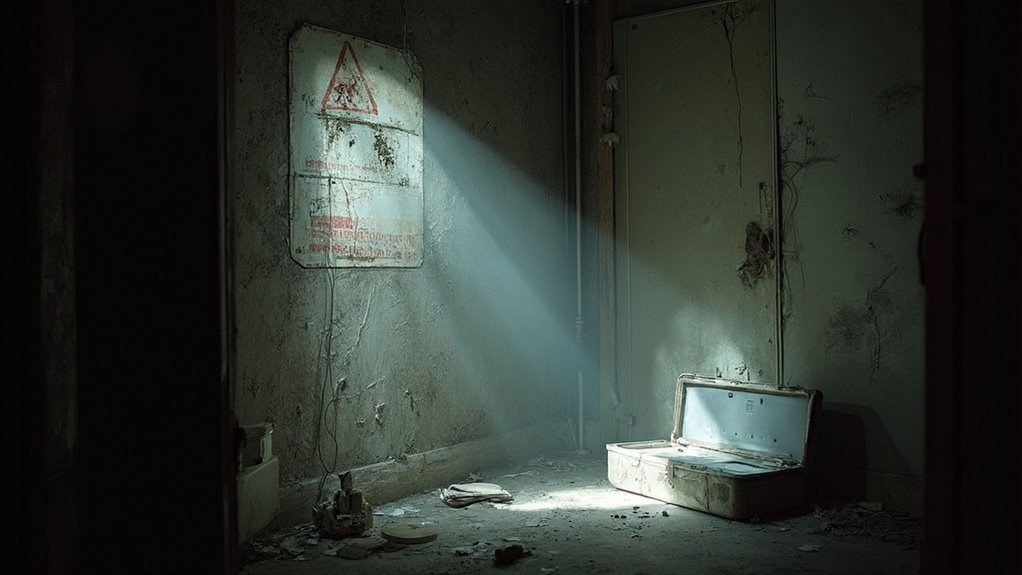Ignoring asbestos in your home is a grave mistake that puts your health at significant risk. Asbestos exposure can lead to severe diseases like asbestosis, lung cancer, and mesothelioma. Even minor disturbances can release harmful fibers into the air, with long-term exposure drastically increasing your health risks. Many homes, especially those built before the 1980s, may contain asbestos in materials like insulation, tiles, and ceilings. Professional testing and certified removal are crucial for safety. By staying informed, you can protect yourself and your family from these dangers. Learn how to assess and manage these risks effectively.
Understanding Asbestos Health Risks

Understanding the health risks associated with asbestos is crucial for any homeowner. Asbestos types, including chrysotile, amosite, and crocidolite, were commonly used in building materials because of their fire-resistant properties. Nevertheless, when these materials become damaged, they can release microscopic fibers into the air. You might not realize it, but exposure sources can range from deteriorating insulation to floor tiles and roofing materials. Once airborne, these fibers can linger for days, making their way deep into your lungs.
The consequences of inhaling asbestos fibers can be severe. You could develop asbestosis, which scars lung tissue, or even more aggressive conditions like mesothelioma and lung cancer. Significantly, there's no safe level of asbestos exposure; even small amounts can lead to significant health issues. All asbestos fibers are harmful if breathed, which underscores the importance of addressing any potential sources in your home. Recent studies indicate that approximately 255,000 deaths annually are linked to asbestos-related diseases, highlighting the seriousness of this issue. Symptoms often take 20 to 50 years to surface, so you may not immediately recognize the risks associated with your home's materials. Early signs like coughing and shortness of breath may indicate long-term exposure. Being informed about these risks helps you make better choices regarding the management of any asbestos-containing materials in your home.
Exposure Statistics You Should Know
As you consider the risks of asbestos in your home, it's essential to understand the staggering annual death toll linked to exposure. Historical data reveals that many workers were unknowingly subjected to hazardous conditions, and current workplace environments still pose significant risks. Knowing these statistics can help you assess your potential exposure and take necessary precautions. Approximately 1,300 Americans die annually from asbestos-related conditions, highlighting the importance of awareness.
Annual Death Toll
Every year, asbestos exposure claims an estimated 40,764 lives in the U.S., according to data from the Institute for Health Metrics and Evaluation (IHME). This staggering figure highlights the urgency of addressing asbestos in your home. The variances in asbestos statistics from various sources merely emphasize the critical need for awareness.
Here's a closer look at the impact of asbestos exposure:
| Disease Type | Annual Fatalities | Source |
|---|---|---|
| Mesothelioma | 20,000 | EWG Action Fund (1999-2013) |
| Lung Cancer | 14,000 | WHO |
| Asbestosis | 6,000 | CDC (1999-2005) |
| Other Cancers | 1,764 | IHME |
These numbers illustrate the severe health risks associated with asbestos, including lung cancer and asbestosis. There's no safe level of exposure, and the potential for long-term health effects is real, often without immediate symptoms. By ignoring the presence of asbestos in your home, you're not just risking your health; you're likewise endangering the lives of those you love.
Historical Worker Exposure
Between 1940 and 1979, an estimated 27 million workers in the United States faced significant exposure to aerosolized asbestos fibers, marking a vital period in occupational health history. This historical exposure highlights severe occupational hazards that affected various industries.
Consider these key points:
- Industries Affected: Workers in construction, mining, and manufacturing were at the highest risk of asbestos exposure.
- Secondary Exposure: Families of asbestos workers were likewise at risk, inhaling fibers from contaminated clothing and hair.
- Health Consequences: Prolonged exposure can lead to serious health issues, including lung cancer and asbestosis, with a latency period of 10 to 40 years.
Mortality rates related to asbestosis have surged since the 1960s and are expected to persist for decades. The dangers of historical exposure to asbestos not only impacted those who directly handled it but also extended to countless others, showcasing the far-reaching implications of occupational hazards. Understanding this history is essential as it underscores the importance of vigilance in homes and workplaces today.
Current Workplace Risks
Historical exposure to asbestos has shaped our understanding of occupational hazards, but the risks persist in today's workplaces. Currently, 1.3 million American workers are still exposed to asbestos, with a staggering 82% of construction sites exceeding OSHA's permissible exposure limit during renovation and demolition activities. High-risk jobs, including asbestos mining, shipyard work, and brake mechanics, continue to face significant dangers.
From 1987 to 1994, 6.3% of workers were exposed to asbestos above recommended limits, which dropped to 4.3% from 2000 to 2003. Nevertheless, these numbers highlight an ongoing issue. Insulation workers are over 10 times more likely to develop mesothelioma, while firefighters encounter heightened asbestos levels during emergencies, doubling their risk.
Moreover, construction jobs account for 25% of asbestosis deaths. With 20% of air at construction sites frequently exceeding OSHA's PEL, immediate exposures can reach alarming levels. Asbestos regulations aim to protect workers, yet the persistent risks demand vigilance for workplace safety. It's vital to be aware of the potential hazards and advocate for safer environments wherever possible.
Common Asbestos Locations in Homes

When inspecting your home for asbestos, you should pay close attention to popcorn ceilings and vinyl tiles. These materials often contain asbestos fibers that can pose serious health risks if disturbed. Identifying and managing these common locations is essential for maintaining a safe living environment.
Popcorn Ceilings Risks
Many homeowners may not realize that the once-popular popcorn ceilings, especially those installed before the 1980s, often contain asbestos, posing significant health risks. If you have these ceilings in your home, it's vital to understand the potential dangers associated with them.
Here are three key points to keep in mind regarding popcorn ceiling safety:
- Asbestos Presence: Popcorn ceilings can release dangerous fibers when disturbed, whether through renovations or normal wear and tear.
- Health Risks: Even a single exposure to asbestos fibers can increase your risk of developing serious diseases, including mesothelioma, which can take decades to manifest.
- Professional Testing: Visual inspection isn't enough; you need professional testing to confirm whether your popcorn ceiling contains asbestos.
If you suspect your ceiling might be hazardous, avoid disturbing it. Instead, prioritize popcorn ceiling removal by hiring certified asbestos abatement professionals. They can safely handle and dispose of the material, ensuring your home remains a safe environment. Don't take unnecessary risks—understanding and addressing popcorn ceiling risks is fundamental for your health and safety.
Vinyl Tile Dangers
Asbestos-containing vinyl tiles, often found in homes built before the 1980s, pose significant health risks that homeowners should not overlook. These tiles were manufactured using asbestos for added strength and heat resistance, which is now understood to be a serious concern. The vinyl tile hazards arise when these tiles are disturbed or damaged, releasing toxic asbestos fibers into the air. Exposure to such fibers can lead to severe diseases, including lung cancer, mesothelioma, and asbestosis.
Identifying these tiles can be vital for asbestos awareness. Typically, they measure 9×9, 12×12, or 18×18 inches and come in light colors like pink, green, cream, or blue. They may likewise be hidden beneath newer flooring layers, complicating identification. If you suspect your home contains these tiles, never attempt to remove them yourself. Doing so can increase exposure risks, as asbestos fibers become friable when disturbed.
Instead, consider professional testing and remediation. Sealing or encapsulating the tiles is often safer than removal. By managing these materials properly, you minimize health risks while ensuring your home remains a safe environment.
Safe Practices for Asbestos Management
Managing asbestos safely requires a proactive approach to guarantee the health and safety of occupants and workers. To effectively manage asbestos in your home or workplace, consider these vital practices:
- Identification and Record Keeping: Conduct thorough assessments to identify types, quantities, and locations of asbestos-containing materials (ACMs). Maintain accurate records of surveys and inspections.
- Safe Handling: Leave undamaged ACMs alone. If handling is necessary, wet the material to suppress fiber release and handle it gently to minimize disturbance.
- Containment Measures: Implement effective asbestos containment strategies by erecting physical barriers and creating sealed enclosures. Use negative air pressure systems with HEPA filters to prevent fiber escape during maintenance procedures.
Regular maintenance procedures and awareness training for all occupants and workers are critical. Train everyone on the importance of not disturbing ACMs and recognizing signs of wear. By following these safe practices, you can greatly reduce the risks associated with asbestos exposure while ensuring compliance with regulations. Prioritize safety to protect yourself and those around you.
Testing and Removal Options

Identifying and addressing asbestos in your home is a vital step that follows safe management practices. It's important to pursue professional asbestos testing to guarantee accurate results and minimize health risks. The most frequently used technique is Polarized Light Microscopy (PLM), effective for analyzing building materials. For air samples, Phase Contrast Microscopy (PCM) measures fiber concentrations, while Transmission Electron Microscopy (TEM) identifies smaller fibers and offers higher sensitivity.
Avoid DIY asbestos testing, as it can increase exposure risks through improper handling or inadequate sampling techniques. These kits often fail to provide precise results and may not comply with regulatory standards. Instead, hire certified professionals who follow strict safety protocols and use advanced methods like TEM and PLM for accurate analyses.
If asbestos is found, don't attempt removal yourself. Certified asbestos-removal contractors should manage this process to minimize risks. If the materials are intact and undisturbed, they can typically remain in place. On the other hand, verify all asbestos-containing materials are identified and removed before any renovation or demolition projects. Prioritizing safety measures during removal is vital to prevent fiber release and protect your health.
Global Impact of Asbestos
The pervasive threat of asbestos continues to resonate globally, posing significant health risks and environmental challenges. Each year, over 200,000 deaths occur because of asbestos exposure, primarily from diseases like lung cancer, mesothelioma, and asbestosis. This alarming statistic highlights the urgent need for effective asbestos regulations and global initiatives.
Consider these key points:
- Exposure Scope: Approximately 125 million people are exposed to asbestos in the workplace, with environmental exposure affecting many more.
- Regulatory Framework: While over 50 WHO Member States have banned asbestos, production still reaches 1.3 million metric tons annually.
- Environmental Risks: Asbestos remains in millions of buildings and products, posing ongoing risks to residents, particularly near former mines.
As awareness of asbestos-related diseases spreads, countries are strengthening regulations to combat its use. Nevertheless, the continued presence of asbestos in various forms and consumer products complicates these efforts. Addressing this global impact requires collective action to prioritize public health and implement safer alternatives to asbestos, ensuring a healthier environment for everyone.
Importance of Awareness and Education

Awareness and education about asbestos play an important role in safeguarding public health and preventing exposure. You need to understand that awareness campaigns and educational resources are fundamental for individuals, especially those working in industries where asbestos contact is possible. Training provides critical information about asbestos's properties, common locations, and identification techniques. This knowledge not only helps you comply with regulations but also encourages a culture of safety in the workplace.
By engaging with these educational resources, you can greatly reduce the risk of accidental exposure and its associated health problems. Courses not only teach safe handling and disposal practices but also promote responsible approaches to environmental protection. The training is tailored for workers and supervisors who might disturb asbestos, ensuring they remain informed about the latest risks and legal requirements.
Furthermore, periodic refreshers are important to keep your knowledge up-to-date, as asbestos-related diseases cause approximately 5,000 deaths annually in the UK. Understanding the long-term health effects of asbestos exposure empowers you to take preventive measures, ultimately enhancing public health and creating healthier workspaces. Don't underestimate the significance of awareness and education in managing asbestos safely.
Frequently Asked Questions
How Can I Identify Asbestos Materials in My Home?
So, you want a home makeover? First, master asbestos identification techniques! Check for common asbestos materials like vinyl floor tiles and textured ceilings. Ignoring this could turn your dream home into a hazardous nightmare.
What Should I Do if I Suspect Asbestos Presence?
If you suspect asbestos presence, prioritize asbestos safety by avoiding disturbance. Seal the area and seek a professional inspection. They'll assess the situation and provide guidance on safe handling and potential removal options.
Are There DIY Methods for Asbestos Removal?
Over 1.3 million workers are exposed to asbestos annually. If you're considering DIY techniques for removal, prioritize safety precautions like sealing areas and wearing protective gear to minimize risks while handling asbestos-containing materials.
What Are the Costs Associated With Asbestos Testing?
Asbestos testing costs typically range from $200 to $3,000, depending on property size and test type. Professional assessment guarantees accurate results, minimizing health risks associated with asbestos exposure while adhering to safety regulations and guidelines.
How Does Asbestos Affect Pets in the Home?
Imagine your pet exploring dusty corners; that's where asbestos exposure lurks. This hazardous material can severely impact pet health, leading to respiratory issues and other symptoms. Safeguarding your animal companion is crucial for their well-being.
